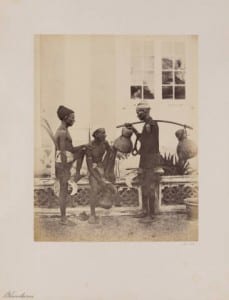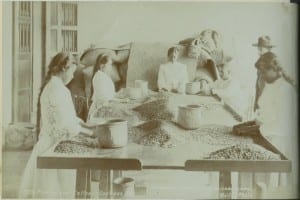The title of this photo is Bhundarees, and it was taken by William Johnson as part of his Photographs of Western India Album. The three men in the picture are barely clothed and appear to be malnourished. This gives off the impression that they are poor. Two of the men are carrying what seem to be ceramic jugs. Bhundarees are wine vendors, and thus it is a strong possibility that there is either wine or sap from a palm tree (an ingredient that is fermented to create wine) in the jugs. Wine vendors are a type of merchant, and thus it is possible that the men in the picture fall into the Vaishyas division of the Indian caste system. However, bhundarees typically take the title of Kshatriyas. The man in the center is sitting on the fence, loosely holding a jug, giving off the impression that he has been seated for at least a moment. The man to the right is carrying two jugs attached on a wooden pole that he has laying across his right shoulder, appearing to have just come retrieving palm or attempting to sell wine. However, the lack of clothing do not lend to the possibility that the Indians are selling wine, but rather that they have been working hard outside in the hot weather. The man to the right and the man to the left are carrying what appear to be sickles, tools used to harvest crops. This is also proof that they have been outside harvesting sap from palm trees in order to create wine. The man to the right also appears to be holding a rope under his right arm, which he probably used to clime up palm trees. The building behind the men could be the house of a wealthy Indian family, evidenced by the large glass, pained, window, and the stone, ornate fence in front. The house may also have British inhabitants, for they were typically wealthier than the Indian people. Whatever the case may be, it is almost certain that the men do not live in the house, especially considering they appear to be taking a break from working to lollygag on the fence in front of it. The lack of clothing in such a public setting does not seem like behavior of the elite or upper classes, so these men must be part of the middle or lower class in India. The man in the center appears to be talking while the other two men listen, one with his hand on the man in the centers shoulder, possibly to console him. The negative expressions on all the men’s faces, and the consoling of one man by another, suggests that the men could be discussing the plight of their situation. Perhaps they are having a tough time harvesting sap, and are negotiating how much more they need to harvest. There is also the possibility that they are taking a much needed break. Conclusively, the men in the image are wine vendors who are part of the Kshatriyas divison of the Indian caste system. The men have been harvesting sap from the palm tree in order to ferment it and turn it into wine. They are currently taking a break and are discussing whether or not to continue retrieving sap, or to return back and start fermenting the sap they have already collected.
The title of the photo is Picking Over Coffee in Coatepec, and it was taken by Charles Burlinghame as part of his Album of people and views of Mexico. The four woman present in the picture are standing at the edge of a large table which contains what appear to be large mounds of coffee beans. The table is situated in a section of a Mexican ranch that is either inside or covered by a roof. Each woman appears to be sorting through the coffee beans and placing them into individual straw baskets situated in front of them on the table. These coffee beans could potentially be sold as is, or ground up and then sold. The women are all wearing the same white dress, which could signify a required uniform. Each woman also has her hair pulled back into the same form of ponytail, again evidence that they are required to wear a uniform. There is a man standing at the right of the picture, a few feet from the table. It is probable that the man in the picture is supervising the woman as they sort through the coffee beans. He is probably a higher profile individual in the company and is in charge of supervising aspects of the harvesting and packaging of the coffee beans. He may also be the owner of the ranch, in which case he would still have the job of supervising his workers. There is a large pile of sacks at the back of the room. These bags probably contain coffee beans, which the woman have sorted into baskets and then placed into the bags. The assumption can be made that the woman are in the midst of a process that involves harvesting, sorting, and selling coffee beans for a company based out of Coatepec Mexico. A large amount of the coffee beans will be exported to the Americas, a big customer for Mexican coffee suppliers during the early 1900s. The women play a role in the sorting component of the process, a component that takes place inside the compound of the ranch. The women are performing work that is not physically taxing, but is rather painstakingly simple and monotonous. The doors in the back left are very large and appear to have hinges that can open to a one hundred and eighty degree angle. This is evidence that the door was created to allow large horses or mules walk through, carrying the sacks of coffee beans. Conclusively, the scene is that of woman who are working in a ranch in Coatepec Mexico. The ranch╒s main commodity is coffee beans, which the woman are sorting and placing into baskets, in order to be placed into sacks that can be sold in the market. The man in the picture is a supervisor, there to check up on the woman, and make sure that they are working efficiently.


